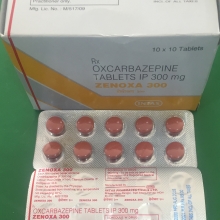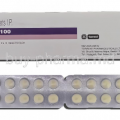Home / Categories / ZENOXA-300MG

ZENOXA-300MG
(10S*10T)
OXCARBAZEPINE-300MG
ANTI-CONVULSANTS
INTAS PHARMACEUTICAL-ALTIMA DIVISION
Product Details
Oxcarbazepine is structurally a derivative of carbamazepine, adding an extra oxygen atom to the benzylcarboxamide group. This difference helps reduce the impact on the liver of metabolizing the drug, and also prevents the serious forms of anemia occasionally associated with carbamazepine. Aside from this reduction in side effects, it is thought to have the same mechanism as carbamazepine - sodium channel inhibition - and is generally used to treat partial seizures in epileptic children and adults.
Indication
For use as monotherapy or adjunctive therapy in the treatment of partial seizures in adults with epilepsy and as adjunctive therapy in the treatment of partial seizures in children ages 4-16 with epilepsy.
Associated Conditions
Pharmacodynamics
Oxcarbazepine is structurally a derivative of carbamazepine, adding an extra oxygen atom to the benzylcarboxamide group. This difference helps reduce the impact on the liver of metabolizing the drug, and also prevents the serious forms of anemia occasionally associated with carbamazepine. Aside from this reduction in side effects, it is thought to have the same mechanism as carbamazepine - sodium channel inhibition - and is generally used to treat the same conditions.
Mechanism of action
The exact mechanism by which oxcarbazepine exerts its anticonvulsant effect is unknown. It is known that the pharmacological activity of oxcarbazepine occurs primarily through its 10-monohydroxy metabolite (MHD). In vitro studies indicate an MHD-induced blockade of voltage-sensitive sodium channels, resulting in stabilization of hyperexcited neuronal membranes, inhibition of repetitive neuronal discharges, and diminution of propagation of synaptic impulses.
Absorption
Completely absorbed following oral administration. Food has no effect on the rate and extent of absorption of oxcarbazepine. After single-dose administration of Trileptal tablets to healthy male volunteers under fasted conditions, the median tmax was 4.5 (range 3 to 13) hours. After single-dose administration of Trileptal oral suspension to healthy male volunteers under fasted conditions, the median tmax was six hours. Steady-state plasma concentrations of MHD are reached within 2-3 days in patients when Trileptal is given twice a day.
Volume of distribution
- 49 L
Protein binding
Approximately 40% of the active 10-monohydroxy metabolite (MHD) is bound to serum proteins, predominantly to albumin. Neither oxcarbazepine nor its MHD binds with alpha-1-acid glycoprotein.
Metabolism
Oxcarbazepine is completely absorbed and extensively metabolized to its pharmacologically active 10-monohydroxy metabolite (MHD) by cytosolic enzymes. MHD is metabolized further by conjugation with glucuronic acid.
Route of elimination
Oxcarbazepine is cleared from the body mostly in the form of metabolites which are predominantly excreted by the kidneys. Fecal excretion accounts for less than 4% of the administered dose.
Half life
The half-life of the parent is about 2 hours, while the half-life of MHD is about 9 hours, so that MHD is responsible for most anti-epileptic activity.
Toxicity
Isolated cases of overdose with oxcarbazepine have been reported. The maximum dose taken was approximately 24,000 mg. All patients recovered with symptomatic treatment.
SOURCE:DRUGBANK

